Abstract
The assessment of the micromorphological characteristics of soils is a powerful tool for studying the transformation of soils under the influence of various weathering mechanisms (physical, biogenic). The central part of Yakutia is characterized by a large area of agricultural lands, some of which has become fallow land and is subject to cryogenic processes, fires and anthropogenic impact. Under the conditions of climate change, the fallow soils of Yakutia can be re-involved in the agricultural complex. To study their state, a method of micromorphological investigation of thin soil sections is proposed. Thin sections of soils were analyzed using a polarizing microscope Leica DM750P. As a result of the work, zonal, fallow, pyrogenic and agricultural soils of the central part of Yakutia were analyzed. The soils were found to be in a degraded state. Zonal soils were characterized by the presence of quartz grains, feldspar, and undecomposed plant tissue, as well as biogenically transformed humus. Fallow soils were characterized by a thick organo-mineral (A) horizon, quartz grains, feldspar, and silty-clay plasma. Pyrogenic soils have differences from natural and fallow soils; as a result of fires and active illuviation of organo-mineral substances. The Anthrosol soils were characterized by a large number of aggregates of various sizes. In their composition there were various minerals, such as quartz, feldspar and mica. The signs of soil cryogenesis were noted only in the underlying horizons (B), while the upper horizon (A) had no signs of cryogenic transformation.
1. Introduction
Today, a significant part of agricultural land is located in Russia. Up to 44 million hectares is in a fallow state, of which 21.6 million hectares are fallow arable land [1,2,3,4]. The Russian government has decided to re-engage an area of these lands, estimated at 12 million hectares [5,6]. In most cases, fallow soils are located in the central part of the country, due to the favorable climatic features of the regions [2,4,6,7]. In the south of the European territory of Russia, fallow lands are actively involved in agriculture, but the lands of Siberia and the Far East still remain in a fallow state [4,8,9]. This is due to the overgrowing of these lands with forests and swamping, as well as active urbanization of the territories [3]. The re-engagement of fallow lands plays an important role in the development of the socio-economic well-being of Russian regions [10,11]. However, over more than 20 years, there has been a critical change in landscapes, soil formation conditions and climate change which have actively influenced the quality of fallow soils and their fertility [12,13].
Under the conditions of climate change, less and less land is exposed to permafrost (cryogenic) processes, there is an increase in the depth of permafrost, a change in redox state, and a change in the micromorphological structure of soils [14,15,16,17]. Degradation of permafrost leads to active development and re-involvement of land in the agricultural complex. Similar work is being carried out in the Yamalo-Nenets Autonomous Okrug, Yakutia, etc. [6,9,12,18]. Today, most of the food products in the Arctic are imported here from more southern regions [19]. However, some of the Arctic regions of the country are able to provide food for themselves by stimulating the agricultural complex [20]. This is due to the fact that in Soviet times there were large agricultural holdings in the Arctic, which provided the local population with all the necessary products [21]. However, after the collapse of the Soviet Union, a significant part of the agricultural land was passed to the fallow state [2]. An important problem is the study of the structure of these soils and the development of certain steps for the successful re-involvement of fallow lands into modern agriculture [6,9,11]. Recently, a large number of works have been published related to the study of biogeochemical cycles in the fallow lands of the Yamalo-Nenets Autonomous Okrug (YNAO) [9,12,13,18], Komi Republic [16], where spatio-temporal patterns of transformation of fallow soils, determination of their toxicological status, and study of biogeochemical cycles have been studied [22,23]. The results of the work carried out show that the fallow lands of the YNAO are characterized by a high content of biogenic elements and can be re-involved in agriculture in the near future [9,12,13]. In Yakutia, such works are rare, although this territory has high potential fertility [8,15]. Here, in comparison with other Arctic regions, the rate of urbanization still remains low and the rural style of farming is preserved [24].
The transformation of fallow land, wildfires and cryogenic processes radically change biogeochemical processes, affect the redox regime, the quantitative and qualitative composition of microorganisms, and also the structure of the soil [8,9,12,16,25,26,27,28]. The morphological and micromorphological structures are responsible for many processes occurring in the soil, such as aeration, the degree of cation exchange capacity, sorption processes, moisture storage, nutrient retention, and many others [27,29,30,31,32,33]. Micromorphological characteristics of soils are a powerful tool for analyzing the structure of the mineralogical and organic matter of the soil [34,35]. Agrogenic and postagrogenic transformation under permafrost conditions is a large-scale type of soil cover evolution under the influence of the anthropogenic factor [9]. Despite the fact that, in Soviet times, there was a huge agricultural network in Yakutia, there are practically no data on agrogenic soils, especially in Yakutsk city [36,37].
The city of Yakutsk is located in the Tuymaada valley on the left bank of the Lena River on modern alluvial deposits with an admixture of pebbles, in its middle course [38]. The central part of Yakutsk is separated from the Lena River by a wide grassy plain and is flooded during high water. The climate is sharply continental, with little annual precipitation (237 mm). The average annual temperature is −8.8 °C. The temperature of the warmest month (July) is 38.4 °C. The temperature of the coldest month (January) is −41.5 °C. According to the Koppen-Geiger classification, this region corresponds to the Subarctic climate (Dfc), but it follows from the classification that this type of climate has short and cool summers, which does not quite match the climatic characteristics of Yakutsk and its surroundings [39]. The formation of the relief is greatly influenced by permafrost, the thickness of permafrost ranges from 180 to 400 m [14]. On average, the seasonal thawing depth is 1.1–1.5 m [14]. On the territory of the city there are many floodplain lakes and oxbow lakes, the largest of which are: Saysary, Teploe, Taloe, Khatyng-Yuryakh, Sergelyakh. The left root bank of the Lena breaks off into the Tuymaada valley with a steep grassy ledge, about 100 m high, covered with steppe vegetation. From the side of the city, the landscape represents the edge of a slightly hilly plain covered with pine–larch taiga and towering above the Lena valley. Soil-forming rocks are represented by alluvial sand, shale and limestone, which creates favorable conditions for agricultural activities in the west of the Lena River [40]. An analysis of the micromorphological structure of the soil makes it possible to consider the details of the dynamics and evolution of soil formation [32,34,41]. Previous work on the micromorphological study of cryogenic soils in the Lena River Delta and the Spitsbergen archipelago showed that a characteristic feature of cryogenic soils is the process of cryo-hydration, which results in the destruction of mineral particles and the accumulation of a clay fraction, as well as the spatial orientation of minerals [25,38,41]. Thus, the main objective of this study is to investigate the micromorphological structure of agrogenic and postagrogenic soils under cryogenic conditions and the degree of their transformation as a result of the transition of soils to a fallow state.
2. Materials and Methods
2.1. Sampling Strategy
Soil sampling was carried out during fieldwork in 2021. Soils were selected from arable and fallow lands. The area of study is shown in Figure 1.
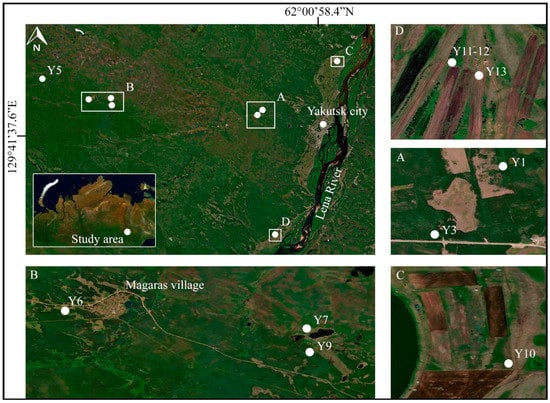
Figure 1.
Study area of fallow, pyrogenic and arable soils in the vicinity of Yakutsk (A–D).
During the study, powerful fires acted in the region, and soils were also selected in areas that were exposed to fire in order to analyze the effect of ground fires on the microstructure of the soil profile. The main criterion in selecting research objects was the coverage of different areas exposed to agriculture in the past and present times. Thus, Y1 is a fallow soil, on which zonal processes of soil formation have been taking place for a long time. The background object, Y3, which has not been exposed to anthropogenic load, was chosen for this site. To study the process of influence of forest fires on micromorphological characteristics of soil, we studied the soil subjected to wildfire (Y5). Near Magaras village, three objects were studied: soil used for cattle grazing (Y6), soil used for haying (Y7), as well as background soil (Y9). To study the micromorphological characteristics of arable soils, we selected several sites in the north and south of Yakutsk (Y10–13). The upper soil horizons, in which the most active soil-forming processes take place, as well as the underlying horizons, were mainly selected as a comparison and for analysis of soil-forming processes.
The studied soils are shown in Figure 2 and Table 1. The additional information about studied soils is presented in Supplementary materials (Table S1).
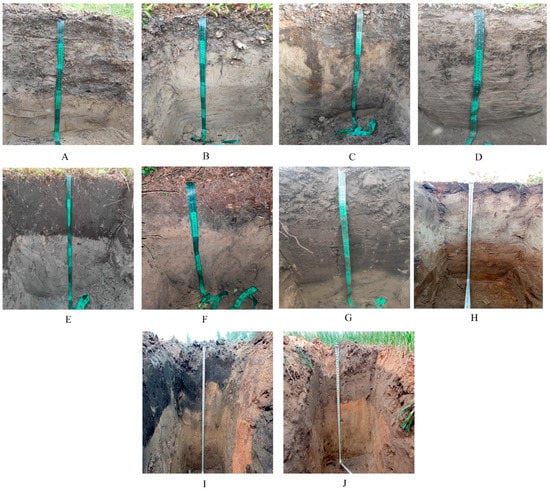
Figure 2.
The studied fallow, arable and pyrogenic soils in the vicinity of Yakutsk. (A) Fallow soil (Y1); (B) Zonal soil (Y3); (C) Pyrogenic soil (Y5); (D) Pasture soil (Y6); (E) Meadow soil (Y7); (F) Zonal soil (Y9); (G) Arable soil (Y10); (H) Zonal soil (Y11); (I) Arable soil (Y12); (J) Arable soil (Y13).

Table 1.
The characteristics of fallow, arable and pyrogenic soils used for micromorphological investigation.
2.2. The Temperature Regime of the Soil
Meteorological station operates in the city of Yakutsk to determine the temperature of the soil at various depths. Thus, in the active layer of permafrost soils, the average annual temperature at a depth of 20 cm is 1.4 °C. Freezing time (soil temperature drops below 0 °C) occurs in December, thawing time (soil temperature rises above 0 °C) begins in June. The description of the soil monoliths used for thin section is presented in Table 2.

Table 2.
Description of the soil monoliths used for thin section.
2.3. Laboratory Methods
Fine sections of soil material were prepared from micro monoliths of soils, sampled in the field. Samples were dried and saturated with resin. The obtained thin sections were analyzed using a polarizing microscope (Leica DM750P, Wetzlar, Germany) with LAS 4.9 software (Wetzlar, Germany) in plane polarized light and crossed polarized nicols. For basic analyses, soil samples were air-dried and sieved through a 2 mm sieve. The terminology used in this paper is published by Gerasimova [32,33] and Stoops [35], where details of the micro-organization of soil were described in detail.
3. Results and Discussion
3.1. Transformation of Soils as a Result of Their Transition to a Fallow State
As a result of the transition of soils to a fallow state the soils radically change their micromorphological characteristics, due to the loss of humus, desiccation, the influence of cryogenic processes (frost cracking), and also the reforestation of the territory. In the studied region, natural soils were represented by Calcic Cryosol, and the depth of occurrence of permafrost reached 1.1–1.5 m. The presence of carbonates was due to their presence in parent materials. Zonal soils had a thin organogenic Ah horizon up to 15 cm, while Anthrosol had an Ahp horizon of up to 26 cm. As a result of the transition of soils into a fallow state, erosion processes were observed, associated with the action of cryogenesis and the drying up of soils in the summer. Cracks had appeared on the surface, and signs of the redistribution of organic matter into the lower soil horizons were evident. In the absence of irrigation, salts from the underlying soil horizons are pulled into the upper organic-accumulative horizons, which led to secondary soil salinization and inhibition of the vegetation cover in profile Y12. In addition to cryogenic processes, seasonal wildfires in Yakutia have a strong influence on soil formation.
The territory of Yakutia is affected by wildfires, the most severe fires took place in 2020–2021 [44], and they radically affect the soil-forming processes in natural and fallow soils. Fire has a strong impact on soil organic matter, which becomes mineralized to end products (H2O and CO2), while also emitting greenhouse gases that contribute to climate change. Under natural conditions, incomplete combustion of soil organic matter occurs, part of the organic residues, together with pyrogenic water (water formed as a result of thermal reaction saturated by humic acids, lignin, and another organic compounds), moves down the profile and accumulates in the middle part of the horizon. The immediate effect of fire on soil microorganisms is to reduce their biomass [45]. In the soil studied by us, humus leakage and redistribution of organic matter down the profile (Y5) were noted. The soil was wetter than the areas that were not affected by the fire. As a result of the fire, litter was destroyed and the upper soil horizon was sprinkled with a layer of ash.
3.2. Micromorphological Structure of Fallow Soils
The micromorphological characteristics of the studied fallow soils (horizon Y1 Ah) are shown in Figure 3. Using micromorphological methods, it was shown that the soil fabric of postagrogenic soils consisted of quartz granules, undecomposed organic tissues, and feldspar, and had a micro mass presented by speckled clay plasma. Quartz granules had a subangular blocky microstructure. Humus was represented by coarse forms with a characteristic fibrous structure, as well as fine organic material, which provided a grayish color of horizon.
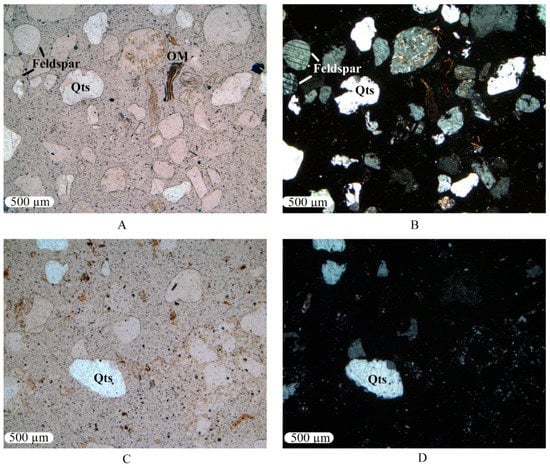
Figure 3.
Micromorphological structure of the Y1 Ah (A,B) and Y3 Ah (C,D) soil profiles. (A,C)—plane polarized light; (B,D)—crossed polarized light. Qts-quartz; OM-organic matter.
Physical alteration processes were noted on quartz grains, but signs of biogenic transformation were not traced. The fallow horizon of the Y1 Abhp profile was characterized by organic fine materials and organic residues having an average degree of decomposition, which indicated active humification processes. Quartz granules and feldspar had signs of alteration and ferrugination along the edges of the minerals. Compared to the upper horizon, Y1 Ah was depleted in clay plasma. This might indicate a weak illuviation process in the horizon. Humus-ferruginous concretions were noted. The soil fabric was represented by quartz, feldspar and single pedo-features. There was a small amount of coal, which indicated the effect of wildfire in the area. To compare the transformation of organo-mineral horizons in fallow soil, we proposed the organo-mineral horizon of zonal soil, Calcic Cryosol, profile Y3 (Figure 3). The soil fabric of Calcic Cryosol was represented by quartz granules, feldspar, and undecomposed organic tissues, as well as organic fine materials. A large number of pedo-features were noted in the soil section. Pedo-features were represented by aggregates of angular blocky microstructure, which indicated the predominance of inherited breed characteristics and poor elaboration of the material.
Thus, fallow soils were distinguished by a deeper elaboration of the material and pedo-features having a subangular blocky microstructure, which indicated active alteration processes in the soil. However, zonal soils showed signs of active biogenic transformation in the soil-forming process.
3.3. Micromorphological Structure of Pyrogenic Soil
We studied Calcic Cryosol (pyrogenic) that was exposed to a wildfire in the spring of 2021. Figure 4 shows the micromorphological structure of the Y5 Ah soil horizon.
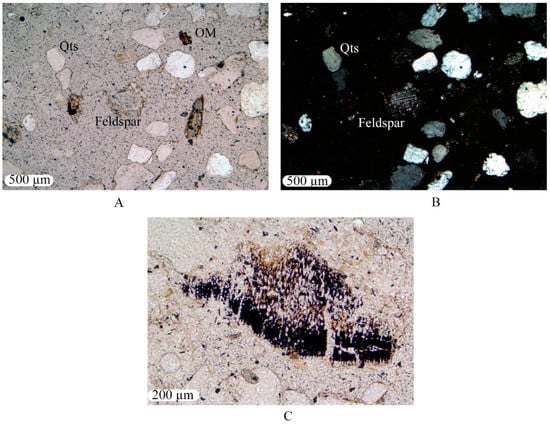
Figure 4.
Micromorphological structure of the Y5 Ah horizon. (A,C)—Plane polarized light; (B) crossed polarized light.
The mineralization of organic matter under the action of a wildfire was quite active, but it depended on the supply of oxygen, and, therefore, both charred plant residues and residues that had not been exposed to fire were present in the upper layers of the soil. However, their content was lower than in the zonal soils of the region. The soil fabric was represented by granules of quartz, feldspar, and single pedo-features with angular blocky microstructure, which indicated weak processes of transformation of soil minerals. The underlying Y5 Btg horizon had a low degree of transformation, as indicated by sporadic pedo-features and a high content of feldspar, which was inherited from the parent rocks. Quartz granules had angular blocky microstructure, which indicated weak alteration processes and organic matter was absent. The greatest interest here was the humus streak, which was the result of the wildfire and the redistribution of organic matter, together with pyrogenic water down the profile. The humus streak was represented by a large amount of pyrogenic organic material. From this, the humus streak acquired a brown color. The soil fabric was presented by grains of quartz, mica and single pedo-features. Carbonized organic matter is the most stable type of organic matter in nature and can persist for quite a long time in the soil. The presence of a clay plasma coating on the surface of pyrogenic carbon was noted, which indicated the process of illuviation of organic matter down the profile.
Calcic Cryosol (Pyrogenic) had differences compared to zonal Calcic Cryosol in the study region. They were reflected in a decrease in the humus content in the upper organo-mineral horizon, illuviation of charred plant residues, and cracking of quartz granules under the influence of high temperatures. The underlying horizons did not undergo transformation and were the place of accumulation of humus, which entered along with pyrogenic water.
3.4. Microstructure of Anthropogenically Transformed Soils Used for Pastures and Hayfields
A characteristic feature of the soils used for pastures was a clear over-consolidation. This phenomenon is typical for all soils on which cattle graze [46]. Figure 5 shows the Y6 Ahd1.
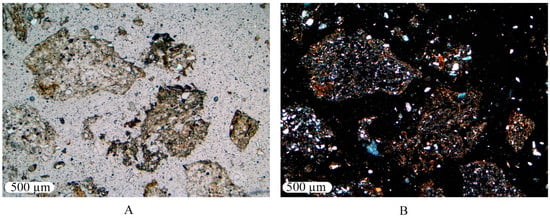
Figure 5.
Micromorphological structure of the pasture soil Y6 Ahd1 profile. (A) plane polarized light; (B) crossed polarized light.
Modern anthropogenically transformed soils have differences from natural and fallow soils. The microstructure of organo-mineral aggregates has an angular blocky structure. Their formation is not associated with any specific structure-forming process, and their development is more often polygenetic in origin and, in this case, was the result of anthropogenic degradation. The underlying Y6 Ahd2 horizon had a similar microstructure to the Ahd1 horizon, but here the presence of colorless quartz granules was noted, which were inherited from the parent rock. The distance between the aggregates increased, and the underlying horizon was looser than the upper horizon. The soil fabric was presented by organo-mineral aggregates, quartz granules, and speckled clay fine material. The formation of aggregates of different sizes and microstructure could indicate cryogenic processes (freezing/thawing).
We analyzed the soils used for the hayfield (Y7 Ahp). In current time, the soils are used for hayfields, but in Soviet times, they were used as arable land. The soil fabric was represented by subangular blocky quartz granules, which indicated the processes of soil alteration, mica inherited from the parent rock, undecomposed organic tissues (single plant fibers are observed), organo-mineral aggregates with an angular blocky microstructure (the result of anthropogenic influence), and speckled silty-clay fine material. Organo-mineral aggregates were unevenly distributed in the soil fabric, which might indicate an active anthropogenic load on these soils. The different size of quartz granules, and their microstructure indicated the processes of plowing in this area. The appearance of mica in the upper humus-accumulative horizon indicated the plowing process in soils, as a result of which the soil profile was mixed. To compare soil transformation processes under hayfield and cattle grazing area, zonal soil Calcic Cryosol, profile Y9 Ah was analyzed.
The microstructure of the zonal soil was similar in structure to the zonal soils of central part of Yakutia previously presented in this study (Y3). The soil fabric was represented by quartz granules with a subangular blocky microstructure, feldspar, and undecomposed organic tissues, as well as organo-mineral aggregates with a subangular blocky micro-structure of biogenic and coprogenic origin. The subangular blocky microstructure of quartz grains indicated weak processes of soil alteration in the profile. The zonal soil had obvious differences in relation to the over-compacted soil that was used for cattle grazing. Cryogenic processes were not expressed here, and organic residues were mainly represented by slightly decomposed plant residues.
3.5. Micromorphology of Soils of Arable Lands
Soils are characterized by the presence of carbonates and easily soluble salts. They have a long history of cultivation, the main stage in the development of these soils for growing crops falls on the Soviet time of hyper-industrialization and the development of the east and north of the USSR. We studied the micromorphological structure of soils in the experimental plot of the agricultural school in Tabaga village (Figure 6), soil profile Y10 Ahp.

Figure 6.
Micromorphological structure of the arable soil Y10 Ahp profile. (A) plane polarized light; (B) crossed polarized light.
The soil fabric of the experimental plot was represented by a large number of aggregates of different sizes, containing various minerals, such as quartz, feldspar and mica. These minerals were of different sizes, which might indicate both an anthropogenic and a biogenic origin of these aggregates. A large number of aggregates indicated active melioration processes of these soils. Weakly decomposed organic residues were not found, which indicated active humification processes in these soils. The soil fabric of the underlying Y10 A/Bp horizon was represented by granules of quartz, mica, organo- mineral aggregates with crumb microstructure, and speckled silty-clay fine material. Organic matter was represented by decomposed organic fine materials. Compared to the upper horizon Y10 Ahp, this horizon was less subject to anthropogenic impact and the biogenic processes of transformation of organo-mineral matter were more developed.
We studied Anthrosols in the southwest vicinity of Yakutsk, located on the 2nd ancient terrace of the Lena River. To study the transformation of soils, background, saline and non-saline soils used in agriculture were studied. Figure 7 shows the microstructure of the background soil Y11 Ah.
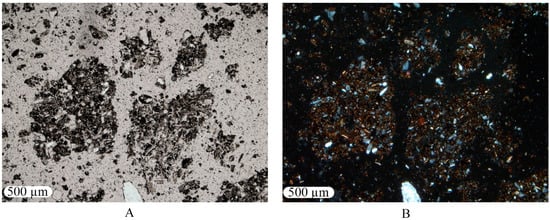
Figure 7.
Micromorphological structure of the arable soil Y11 Ah profile. (A) plane polarized light; (B) crossed polarized light.
The soil fabric was represented by a large number of organo-mineral aggregates with various shapes (angular blocky, subangular blocky rounded and crumb microstructures). This indicated the development of biogenic, coprogenic, and cryogenic processes in the soil. There were single large undecomposed plant tissues. A wide variety of microstructures and sizes of aggregates was largely associated with cryogenic transformation and coagulation. Compared to the background soils in the west vicinity of Yakutsk, the soils in the southeast practically did not have large individual granules of minerals, and had a high aggregation and a high degree of humification of organic residues.
We studied saline soil used for agricultural purposes; due to the pulling up of salts from the underlying layers, the vegetation cover was absent or strongly oppressed. By the high mosaicity of the vegetation cover, salt uplift did not occur in all areas and was due to its high concentration in parent rocks. The soil fabric of Y12 Ahpz was represented by quartz granules, feldspar, and mica, as well as crumb microstructure of organo-mineral aggregates and speckled silty-clay fine material. Organic remains were represented by well-decomposed organic fine materials. The predominance of aggregates with crumb microstructure indicated well developed material.
The underlying horizon Y12 Btz (Figure 8) had a coprogenous microstructure of organic matter. Sphere aggregates with unclear boundaries were formed, which indicated an aging process. The aggregates contained well-decomposed organic matter, as well as individual inclusions of weakly decomposed plant residues. The soil fabric was represented by quartz granules, organo-mineral aggregates, and speckled silty-clay fine material.

Figure 8.
Micromorphological structure of the arable soil Y12 Btz profile. (A) plane polarized light; (B) crossed polarized light.
Figure 9 shows a modern soil profile used in agriculture for growing oats (Y13 Ahp-Bt). The soil fabric of the Y13 Ahp horizon was represented by quartz granules, mica, feldspar, organo-mineral aggregates, with a large number of inclusions of large granules of minerals, and speckled sandy-clay fine material. Mineral granules were highly fractured, which indicated an external impact on the soil, and the aggregates had a subangular microstructure. Anthropogenic impact led to a critical transformation of the soil microstructure. Compared to the natural soil (Y11), the anthropogenically transformed soil Y13 had signs of anthropogenic disturbances and biogenic formation of pedo-features.
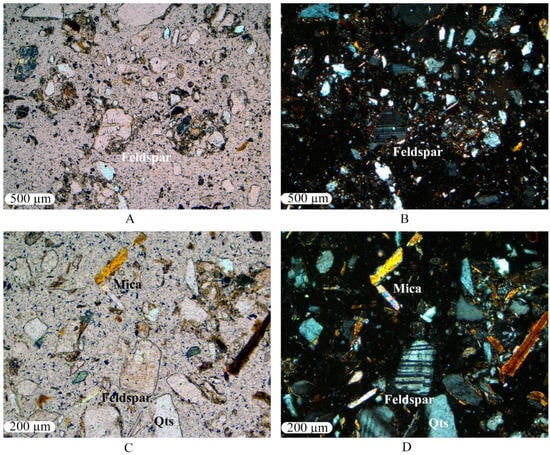
Figure 9.
Micromorphological structure of the arable soil Y13 Ahp (A,B) and Y13 Bt (C,D) soil profiles. (A,C) plane polarized light; (B,D) crossed polarized light.
The soil fabric of Y13 Bt horizon was represented by granules of quartz, feldspar, undecomposed organic tissues, organo-mineral aggregates with a subangular blocky microstructure, and the fine material had a speckled structure and an iron–clay composition. A characteristic feature of the Bt horizon was the presence of clay coatings, which were represented by a coating on skeletal quartz granules and along the periphery of aggregates. The Bt horizon was a classical type of illuvial horizon in Calcic Cryaosol and was less subject to anthropogenic transformation; therefore, it retained the diagnostic features of natural Calcic Cryosol. The upper horizon Y13 Ahp had almost completely lost the microstructure of the natural soil.
Quartz and feldspar had cracks and were represented by an angular blocky microstructure, which indicated a low degree of alteration, a high connection with parent rocks and susceptibility to the cryogenic and coagulation mechanism of soil formation. The accumulation of organic residues and organo-mineral aggregates was associated with the process of illuviation. Calcic Cryosols of the central part of Yakutia and fallow soils are poorly studied objects. However, their genesis is of great interest from the point of view of their involvement and re-involvement in the agricultural complex [36,37]. The fallowing of soils is widely used in tropical areas, such as Colombia, the Andean agroecosystem, fallowing on agricultural lands, as well as slash/mulch which leads to a significant increase in biomass and soil organic material, respectively [47]. The agroecosystem of Yamal, formed under conditions of cryogenesis are characterized by preservation of biogenic elements in the soil [12]. The degradation of fallow soils was observed in the studied Yakutia soils.
To compare the main micromorphological features we present Table 3.

Table 3.
The main micromorphological features in studied soil thin sections.
A sharply continental climate, humus formation on alluvial parent rocks, and cryogenic processes were the key factors of soil formation in this area [8,14]. The upper organic accumulative horizons (A) were mostly not affected by cryogenic processes. The features of the cryogenic processes were noted in the lower soil horizons (Bt). Therefore, these soils could be actively involved in agricultural turnover in this area. In soils that developed in more northern regions, and the Spitsbergen Archipelago, the cryogenic features of the structure of soil minerals (cracking, cryogenic destruction of minerals) were more pronounced [28]. The action of cryogenic processes was also accompanied by the presence of large pores in the micromorphological structure of soil profiles, ice lenses and prismatic structure [48]. However, the action of cryogenic processes in the soils studied by us was not so actively expressed, which was associated with the milder climatic features of the region. One of the main features of the cryogenic microstructure is the vertical orientation of the minerals; thus, we previously noted this phenomenon in the soils of the Lena River delta [41], while in the studied soils of Yakutsk such a feature was not noted. In the studied soils cryogenic processes were represented by the formation of different sized organo-mineral aggregates, as well as a wide pore space between minerals and aggregates. The formation of silt capping on the surface of pedo-features in the studied thin soil sections might indicate freezing/thawing processes occurring here [48]. The low activity of cryogenic processes might be related to the climatic features of the region, which were associated with a sharply continental climate, (rapid freezing of soils and rapid thawing). The most active freezing–thawing processes are characteristic of the slow freezing of soils and their slow thawing [48]. Natural wildfires also have a negative effect on soils, the fight against which is a key problem in Yakutia [44], associated with the low population density of the territory [44]. Thus, the main distinguishing features of the studied soils were the following: the presence of large amounts of ash (pyrogenic soils), and the presence of organic fine materials (zonal and fallow soils), as well as the presence of a significant amount of pedo-features, characteristic of soils involved in modern agricultural practices.
4. Conclusions
As a result of the study, we investigated zonal Calcic Cryosol, and fallow and Calcic Cryosol (pyrogenic) soils, as well as arable Anthrosol. Calcic Cryosols were characterized by quartz granules, feldspar, undecomposed plant tissues, and biogenically transformed humus. Quartz granules had angular and subangular blocky microstructures, which indicated a weak process of alteration. The speckled silty-clay fine material contributed to the illuviation of organo-mineral aggregates down the profile and their accumulation in the middle part of the soil profile. Fallow soils were characterized by a thick organo-accumulative horizon, quartz granules, undecomposed organic tissues, feldspar, and speckled silty-clay fine material. Mineral granules had an angular blocky microstructure, which indicated active processes of soil alteration. Organo-mineral aggregates with well-decomposed organic fine material were formed in the fallow horizon. Pyrogenic soils had differences between the zonal and fallow soils. As a result of fires, active illuviation of organo-mineral substances occurred down the profile. Organic matter was represented in the form of coal, which is less accessible to plants. In order to involve the pyrogenic soils in the agricultural complex, it will be necessary to carry out additional reclamation procedures to saturate the upper affected soil horizon with organic matter. Anthrosols were characterized by a large number of aggregates of different sizes, and in their composition there were various minerals, such as quartz, feldspar and mica. The high diversity of microstructures and sizes of aggregates might indicate both anthropogenic and biogenic origin of these aggregates, as well as active melioration of these soils.
Supplementary Materials
The following supporting information can be downloaded at: https://www.mdpi.com/article/10.3390/soilsystems6030068/s1, Table S1: The main physical characteristics of studied soils.
Author Contributions
V.P. and A.P. performed the expedition with fieldwork and soil sampling; V.P., E.A. paper writing laboratory analyses V.P., E.A., A.P. field research, conceptualization. All authors have read and agreed to the published version of the manuscript.
Funding
This work was supported by the Ministry of Science and Higher Education of the Russian Federation in accordance with agreement № 075-15-2022-322 date 22 April 2022 on providing a grant in the form of subsidies from the Federal budget of Russian Federation. The grant was provided for state support for the creation and development of a World-class Scientific Center “Agrotechnologies for the Future”. The article in honor of the 300th anniversary of St. Petersburg State University. We thank Saint-Petersburg University for access to Leica DM750P microscope.
Institutional Review Board Statement
Not applicable.
Informed Consent Statement
Not applicable.
Data Availability Statement
The data that support the findings of this study are available from the corresponding author, upon reasonable request.
Conflicts of Interest
The authors declare no conflict of interest.
References
- Romanovskaya, A.A. Organic carbon in long-fallow lands of Russia. Eurasian Soil Sci. 2006, 39, 44–52. [Google Scholar] [CrossRef]
- Zhidkin, A.; Fomicheva, D.; Ivanova, N.; Dostál, T.; Yurova, A.; Komissarov, M.; Krása, J. A detailed reconstruction of changes in the factors and parameters of soil erosion over the past 250 years in the forest zone of European Russia (Moscow region). Int. Soil Water Conserv. Res. 2022, 10, 149–160. [Google Scholar] [CrossRef]
- Orlova, O. Struggle for the ground: Restoration of laylands. Karelian Sci. J. 2015, 2, 130–133. [Google Scholar]
- Nekrich, A.S.; Lyuri, D.I. Changes of the Dynamic of Agrarian Lands of Russia in 1990–2014. Izv. Ross. Akad. Nauk. Seriya Geogr. 2019, 3, 64–77. [Google Scholar] [CrossRef]
- Mikhailova, A. Unplowed Field: Is It Worth Returning Fallow Lands to Circulation? Available online: https://www.agroinvestor.ru/analytics/news/34684-nepakhanoe-pole-stoit-li-vozvrashchat-v-oborot-zalezhnye-zemli/ (accessed on 2 June 2022).
- Ivanov, A.L.; Savin, I.Y.; Stolbovoy, V.S.; Dukhanin, Y.A.; Kozlov, D.N.; Bamatov, I.M. Global climate and soil cover—Implications for land use in Russia. Dokuchaev Soil Bull. 2021, 107, 5–32. [Google Scholar] [CrossRef]
- Ioffe, G.; Nefedova, T.; de Beurs, K. Land Abandonment in Russia. Eurasian Geogr. Econ. 2012, 53, 527–549. [Google Scholar] [CrossRef]
- Polyakov, V.; Nizamutdinov, T.; Abakumov, E.; Morgun, E. Soil Diversity and Key Functional Characteristics of Yakutsk City: Largest Urbanized Cryogenic World’s Ecosystem. Energies 2021, 14, 3819. [Google Scholar] [CrossRef]
- Abakumov, E.; Morgun, E.; Pechkin, A.; Polyakov, V. Abandoned agricultural soils from the central part of the Yamal region of Russia: Morphology, diversity, and chemical properties. Open Agric. 2020, 5, 94–106. [Google Scholar] [CrossRef]
- Savin, I.Y.; Stolbovoy, V.S.; Avetyan, S.A.; Shishkonakova, E.A. Map of plowed soils of Russia. Dokuchaev Soil Bull. 2018, 94, 38–56. [Google Scholar] [CrossRef]
- Stolbovoy, V.S.; Petrosyan, R.D.; Shilov, P.M.; Lukianov, S.N. Increasing the efficiency of investments on survey of abundant land for their return to agricultural use. Dokuchaev Soil Bull. 2021, 108, 83–103. [Google Scholar] [CrossRef]
- Nizamutdinov, T.; Abakumov, E.; Morgun, E.; Loktev, R.; Kolesnikov, R. Agrochemical and Pollution Status of Urbanized Agricultural Soils in the Central Part of Yamal Region. Energies 2021, 14, 4080. [Google Scholar] [CrossRef]
- Lyuri, D.I.; Nekrich, A.S.; Karelin, D.V. Cropland dynamics in Russia in 1990–2015 and soil emission of carbon dioxide. Vestn. Mosk. Univ. Seriya 5 Geogr. 2018, 3, 70–76. [Google Scholar]
- Desyatkin, R.V.; Desyatkin, A.R.; Fedorov, P.P. Temperature regime of the forest soils, Central Yakutia. Earth’s Cryosphere 2012, 16, 70–78. [Google Scholar]
- Desyatkin, R.; Filippov, N.; Desyatkin, A.; Konyushkov, D.; Goryachkin, S. Degradation of Arable Soils in Central Yakutia: Negative Consequences of Global Warming for Yedoma Landscapes. Front. Earth Sci. 2021, 9, 795. [Google Scholar] [CrossRef]
- Kaverin, D.A.; Pastukhov, A.V.; Panjukov, A.N. Soil Temperature Regime in Postagrogenic Ecosystems Under the Expansion of Self-Restoring Succession of Tundra Vegetation (European Northeast of Russia). Earth’s Cryosphere 2019, 23, 58–66. [Google Scholar]
- Stolbovaya, V.S.; Savin, I.Y. Can Russian agricultural soils affect climate change? Nat. Russ. 2018, 1, 1. [Google Scholar]
- Morgun, E.N.; Abakumov, E.V. Agricultural research and crop yields in the Yamal-Nenets Autonomous District: Retrospective analysis (1932–2019). Nauchnyy Vestn. Yamalo-Nenetskogo Avton. Okruga 2019, 3, 4–9. [Google Scholar]
- Nikitenko, M.E.; Trofimova, I.B. Food security in the Arctic zone of the Russian Federation. Soc. Politics Econ. Law 2016, 9, 1–5. [Google Scholar]
- Ivanov, V.A. Features of ensuring food security of the population of the North and the Russian Arctic. Arkt. Ecol. Econ. 2021, 11, 596–606. [Google Scholar]
- Alekseeva, L. The formation of Arctic agriculture in the USSR (Yamal). Bull. Nizhnevartovsk State Univ. 2017, 2, 3–10. [Google Scholar]
- Archegova, I.B.; Panyukov, A.N.; Andrianov, V.A. Opportunities and economic feasibility of agriculture in the tundra. North Mark. Form. Econ. 2013, 1, 12–15. [Google Scholar]
- Panyukov, A.N. Restorative succession on deposits in the conditions of the Eastern European tundra. Intern. Mag. Appl. Funds Res. 2013, 8, 235–238. [Google Scholar]
- Laruelle, M. The three waves of Arctic urbanisation. Drivers, evolutions, prospects. Polar Rec. 2019, 55, 1–12. [Google Scholar] [CrossRef]
- Konistsev, V.; Rogov, V. Micromorphology of cryogenic soils. Eurasian Soil Sci. 1977, 2, 119–125. [Google Scholar]
- Makeev, O. The Soil Cryology; Russian Academy of Science: Moscow, Russia, 2019; p. 464. [Google Scholar]
- Smith, C.A.S.; Fox, C.A.; Hargrave, A.E. Development of soil structure in some turbic cryosols in the Canadian low Arctic. Can. J. Soil Sci. 1991, 71, 11–29. [Google Scholar] [CrossRef]
- Szymański, W.; Skiba, M.; Wojtuń, B.; Drewnik, M. Soil properties, micromorphology, and mineralogy of Cryosols from sorted and unsorted patterned grounds in the Hornsund area, SW Spitsbergen. Geoderma 2015, 253, 1–11. [Google Scholar] [CrossRef]
- Abakumov, E.V.; Gagarina, E.I.; Sapega, V.F.; Vlasov, D.Y. Micromorphological features of the fine earth and skeletal fractions of soils of West Antarctica in the areas of Russian Antarctic stations. Eurasian Soil Sci. 2013, 46, 1219–1229. [Google Scholar] [CrossRef]
- Ilieva, R.; Vergilov, Z.; Groseve, M. Micromorphology of organic matter in the Antarctic soils. Bulg. J. Ecol. Sci. 2003, 2, 52–54. [Google Scholar]
- Van Vliet-Lanoë, B.; Fox, C.A.; Gubin, S.V. Micromorphology of Cryosols. In Cryosols: Permafrost-Affected Soils; Kimble, J.M., Ed.; Springer: Berlin/Heidelberg, Germany, 2004; pp. 365–390. [Google Scholar] [CrossRef]
- Gerasimova, M.I.; Savitskaya, N.V. Micromorphological Interpretation of Natural and Anthropogenic Evolution of Soils in Bykovo Lacustrine-Alluvial Section of the Moskva River Floodplain. Eurasian Soil Sci. 2020, 53, 950–959. [Google Scholar] [CrossRef]
- Gerasimova, M.; Kovda, I.; Lebedeva, M.; Tursina, T. Micromorphological Terms: The State of the Art in Soil Microfabric Research. Eurasian Soil Sci. 2011, 44, 739–752. [Google Scholar] [CrossRef]
- Gerasimova, M.; Lebedeva, M. Contribution of Micromorphology to Classification of Aridic Soils. In New Trends Soil Micromorphol.; Springer Science & Business Media: Berlin, Germany, 2008; pp. 151–162. [Google Scholar] [CrossRef]
- Stoops, G. Mineral and Organic Constituents. In Guidelines for Analysis and Description of Soil and Regolith Thin Sections; Wiley: Hoboken, NJ, USA, 2020; pp. 87–126. [Google Scholar] [CrossRef]
- Elovskaya, L.G. Soils of Arable Farming Regions in Yakutia and the Ways to Improve Their Fertility; Yakutsk Knizhn. Izd.: Yakutsk, Russia, 1964. [Google Scholar]
- Elovskaya, L.G.; Konorovskii, A.K. Regionalization and Reclamation of Permafrost-Affected Soils of Yakutia; Nauka: Novosibirsk, Russia, 1978. [Google Scholar]
- Polyakov, V.; Orlova, K.; Abakumov, E. Soils of the Lena River Delta, Yakutia, Russia: Diversity, Characteristics and Humic Acids Molecular Composition. Polarforschung 2018, 88, 135–150. [Google Scholar]
- Arnfield, J.; Köppen Climate Classification. Encyclopedia Britannica. 2020. Available online: https://www.britannica.com/science/Koppen-climate-classification (accessed on 1 August 2022).
- Okonesnikova, M.V.; Ivanova, A.Z. Soils and technogenic surface formations of an industrial base of Yakutsk city. Vestn. North-East. Fed. Univ. 2020, 6, 5–19. [Google Scholar] [CrossRef]
- Polyakov, V.; Abakumov, E. Micromorphological Characteristic of Different-Aged Cryosols from the East Part of Lena River Delta, Siberia, Russia. Geosciences 2021, 11, 118. [Google Scholar] [CrossRef]
- Jahn, R.; Blume, H.P.; Spaargaren, O.; Schad, P. Guidelines for Soil Description; Food and Agriculture Organization of the United Nations: Rome, Italy, 2006. [Google Scholar]
- WRB, F. IUSS Working Group WRB World Reference Base for Soil Resources 2014, Update 2015; FAO: Rome, Italy, 2015; p. 195. [Google Scholar]
- On the State of Protection of the Population and Territories of the Russian Federation from Natural and Man-Made Emergencies in 2021; Ministry of the Russian Federation for Civil Defense; Academy of Civil Protection EMERCOM of Russia: Moscow, Russia, 2022; p. 250.
- Abakumov, E.; Maksimova, E.; Tsibart, A. Assessment of postfire soils degradation dynamics: Stability and molecular composition of humic acids with use of spectroscopy methods. Land Degrad. Dev. 2018, 29, 2092–2101. [Google Scholar] [CrossRef]
- Sharrow, S. Soil compaction by grazing livestock in silvopastures as evidenced by changes in soil physical properties. Agrofor. Syst. 2007, 71, 215–223. [Google Scholar] [CrossRef]
- Barrios, E.; Cobo, J.; Rao, I.; Thomas, R.; Amezquita, E.; Jimenez, J.; Rondon, M. Fallow management for soil fertility recovery in tropical Andean agroecosystems in Colombia. Agric. Ecosyst. Environ. 2005, 110, 29–42. [Google Scholar] [CrossRef]
- Vliet-Lanoë, B.V. 6—Frost Action. In Interpretation of Micromorphological Features of Soils and Regoliths; Stoops, G., Marcelino, V., Mees, F., Eds.; Elsevier: Amsterdam, The Netherlands, 2010; pp. 81–108. [Google Scholar] [CrossRef]
Publisher’s Note: MDPI stays neutral with regard to jurisdictional claims in published maps and institutional affiliations. |
© 2022 by the authors. Licensee MDPI, Basel, Switzerland. This article is an open access article distributed under the terms and conditions of the Creative Commons Attribution (CC BY) license (https://creativecommons.org/licenses/by/4.0/).